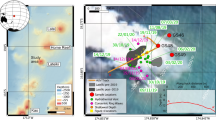Abstract
PROF. OMORI has recently published a second valuable memoir on the eruption of Sakura-jima, which occurred on January 12, 1914.1 The volcano lies in Kagoshima Bay, in South Japan, a few miles to the east of the city of Kagoshima. Until the last eruption Sakura-jima was an island. It is now connected by a lava-stream with the east side of the bay. The part of the bay lying to the north of Sakura-jima ranges in depth from 70 to 107 fathoms, and is apparently of the same origin as the deep lakes which are found behind the sea-coast volcanoes of Usu-san and Tarumai-san.
This is a preview of subscription content, access via your institution
Access options
Subscribe to this journal
Receive 51 print issues and online access
$199.00 per year
only $3.90 per issue
Buy this article
- Purchase on Springer Link
- Instant access to full article PDF
Prices may be subject to local taxes which are calculated during checkout
Similar content being viewed by others
References
The Sakura-jima Eruptions and Earthquakes II. Bull. Imp Earthq. Inv. Com., vol. viii., 1916, pp. 35 179. The first memoir was noticed in NATURE, vol. xciv., p. 289; see also vol. xcii., pp. 716 17.
Rights and permissions
About this article
Cite this article
DAVISON, C. The Sakura-Jima Eruption of January, 1914. Nature 98, 57–58 (1916). https://doi.org/10.1038/098057b0
Issue Date:
DOI: https://doi.org/10.1038/098057b0
Comments
By submitting a comment you agree to abide by our Terms and Community Guidelines. If you find something abusive or that does not comply with our terms or guidelines please flag it as inappropriate.



